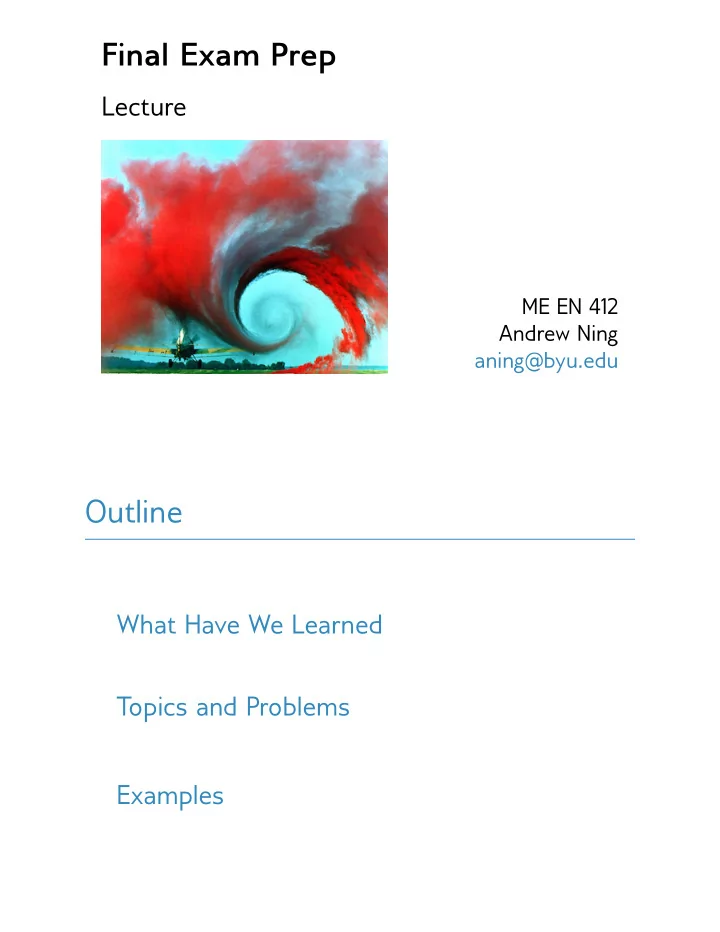

Final Exam Prep Lecture ME EN 412 Andrew Ning aning@byu.edu Outline What Have We Learned Topics and Problems Examples
What Have We Learned Topics: • Dimensional Analysis, Balance Laws • Potential Flow, Boundary Layers, Lift and Drag • CFD Theory and Usage • Nozzles, Shock Waves • Fan and Turbine Analysis
Wide range of fluid dynamics: • Incompressible and Compressible • Inviscid and Viscous • Theory, Computation, and Experiment • Applications: wind tunnels, aircraft, propellers, wind turbines, flow around an island, running in the rain, mobula rays, airfoils, multi-element airfoils, jet engines, vortex rings, sonic boom, car aerodynamics, fans, hot air baloons, meteors, supersonic projectiles, sprinklers, pumps, baloon in a car, sailing, sports ball aerodynamics Emphasis on: • Open-ended Problems • Computation • CFD Usage • Applications • True Principles. Connection between Spiritual and Secular.
Topics and Problems Dimensional Analysis • Re, Ma, Fr, St, pressure/lift/drag/power coefficient • Forming nondimensional groups • Similitude
Types of Problems: • Form nondimensional equations • Recognize common groups and what they mean • Similarity analysis (i.e., translate drag from wind turbine to full scale) Balance Laws and Control Volumes • rate of accumulation = rate of inflow - rate of outflow + rate of production • mass balance • linear momentum balance • Bernoulli’s Equation (energy)
Types of Problems: • define appropriate control volumes • mass/momentum balances and Bernoulli’s equation Potential Flow • Laplace’s equation • Basic solutions • Superposition of solutions • Kutta-Joukowski Theorem • D’Almbert’s Paradox
Types of Problems: • Calculate velocity and pressure fields from basic solutions (and superpositions of solutions) • Understand D’Almbert’s Paradox • Compute lift based on circulation Boundary Layers • Boundary Layer Thickness • Displacement Thickness • Momentum Thickness • Laminar and Turbulent • Blasius Solution (and Schlichting empirical formulas) • Momentum Integral Boundary Layer Equation • Transition and Separation
Types of Problems: • Compute boundary layer thicknesses • Understand differences between laminar and turbulent profiles • Use Blasius and Schlichting formulas • Compute skin friction drag • Understand transition and separation Lift and Drag • Circulation • Skin friction drag. Pressure drag. Lift-dependent drag. compressible drag (later) • Integral Methods • Tabular Methods • Downwash
Types of Problems: • Understand difference in different forms of drag, how they arise, how shape and flow conditions affect them, and how they might be computed. • 2D and 3D lift/drag coefficients CFD • Common problems • Theory • Verification and Validation • Richardson extrapolation • y+ • RANS/LES/DNS
Types of Problems: • CFD Concepts • y+ calculation • Richardson extrapolation calculation Compressible Flow • Thermodynamics • Energy Equation • Speed of Sound • Total/Stagnation Properties • f ( M ) mass balance equation • over/under expanded • compressible drag • Normal shock waves • oblique shock waves
Types of Problems: • Thermodynamic relationships • compute speed of sound • compute total properties • nozzle analyses including nozzles with normal shocks • normal/oblique shock calculations • compressibility drag for simple shapes Turbomachines • Pump vs a turbine • Torque and rotation • Velocity triangles • Angular momentum balance
Types of Problems: • Identify a pump vs a turbine • Radial flow rotor analysis • Axial flow rotor analysis • Torque, Power, mass flow, work per unit mass Examples
• 7-48: dimensional analysis • 5-36: control volume • 6-69: potential flow • 9-21: boundary layer thickness • 9-52: skin friction drag • 11-70: nozzle/shock • 12-50: turbomachine
Recommend
More recommend